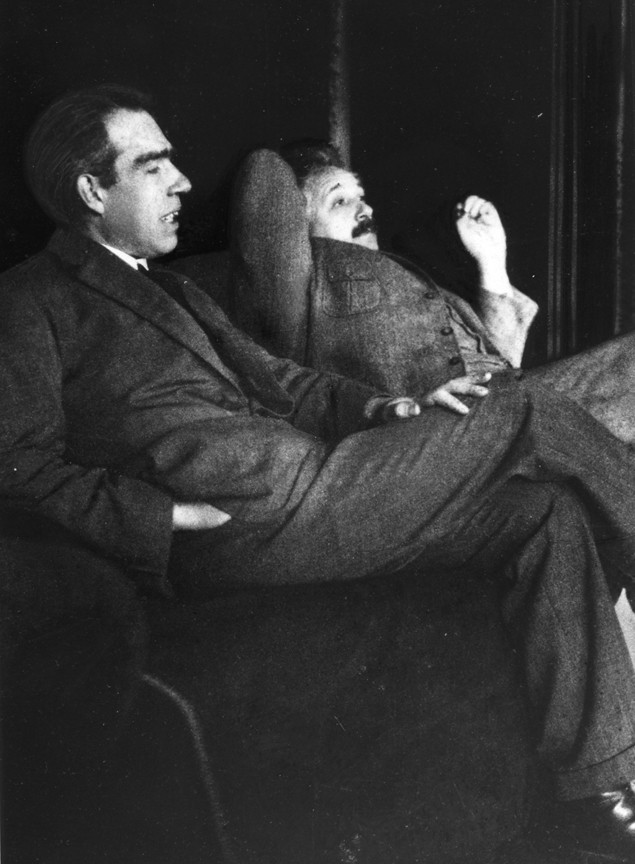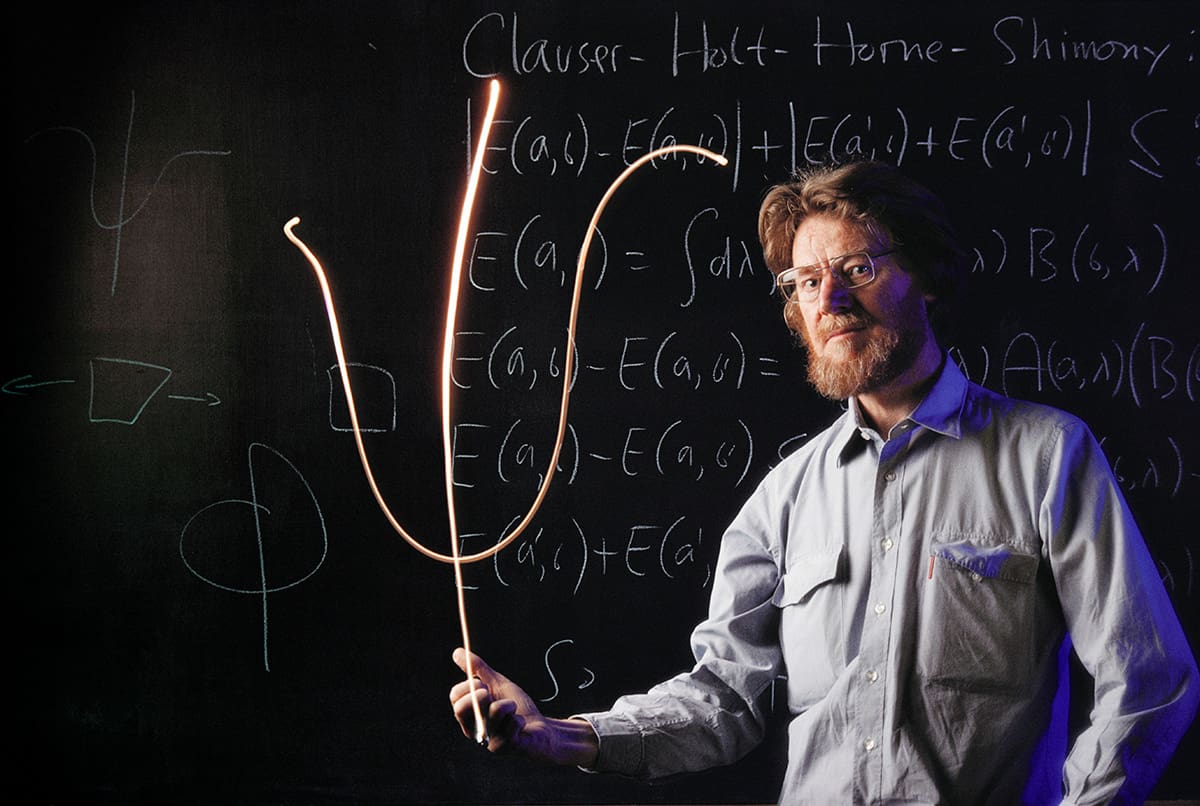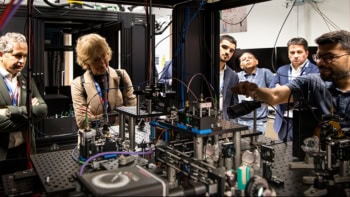Despite its many successes, physicists are still struggling to nail down a coherent interpretation of quantum mechanics, as it best represents “reality”. Jim Baggott explores the arguments first put forth by John Bell three decades ago, and looks at theoretical and experimental evidence accumulated since
“Surely, after 62 years, we should have an exact formulation of some serious part of quantum mechanics?” wrote the eminent Northern Irish physicist John Bell in the opening salvo of his Physics World article, “Against ‘measurement’ ”. Published in August 1990 just two months before his untimely death at the age of 62, Bell’s article outlined his concerns. As he further explained, “By ‘exact’ I do not of course mean ‘exactly true’. I mean only that the theory should be fully formulated in mathematical terms, with nothing left to the discretion of the theoretical physicist…until workable approximations are needed in applications.”
Although Bell spent the majority of his career as a theoretical particle physicist and worked on accelerator design at the CERN lab in Geneva, today he is best known for his contributions to deep, foundational questions that probe the meaning of quantum mechanics. Nearly a century after it was first formulated, there is still no consensus among physicists on how the theory should be interpreted. “I think I can safely say that nobody understands quantum mechanics,” Richard Feynman famously declared – a rather extraordinary admission for a foundational theory that underpins much of our understanding of modern physics.

Against ‘measurement’: John Bell on our continuing struggles with quantum mechanics
Indeed, the debate about the interpretation of quantum mechanics, which began in 1927, continues to this day. It became polarized around the views of its two leading protagonists – Niels Bohr and Albert Einstein. In essence, this was a debate about the meaning of the theory’s central concept, the quantum wavefunction – a mathematical description of the quantum state of a system, which contains all its measurable information.
According to Bohr the wavefunction shouldn’t be taken as a literal representation of the real physical state of a real physical system. While he acknowledged its importance and significance in solving quantum problems, he insisted that “it must be recognized, however, that we are here dealing with a purely symbolic procedure, the unambiguous physical interpretation of which in the last resort requires a reference to a complete experimental arrangement” (Essays 1958–1962 on Atomic Physics and Human Knowledge, Wiley Interscience). Indeed, he is famously quoted as saying “There is no quantum world. There is only an abstract quantum physical description.”
For Bohr, the quantum formalism is a “purely symbolic procedure” that lets us use our experiences of past measurements to predict the results of future ones. On this understanding all measurements are classical, as this is the only kind of physics we can experience directly. But the quantum nature of the objects under study means that the apparatus and the way it is set up determines what we can expect to observe. With one kind of apparatus we can choose to observe the wave-like nature of a “beam” of electrons. With another kind of apparatus, we can choose to observe the particle-like nature of individual electrons. These are mutually exclusive, not because we lack the ingenuity to conceive of an apparatus to expose both types of behaviour simultaneously, but because such an apparatus is simply inconceivable.
According to Bohr what we cannot do is go beyond these complementary descriptions and say what an electron actually is when it is not being observed. This became known as the “Copenhagen interpretation”, named after the location of Bohr’s Institute for Theoretical Physics. This and other variants on the general theme of the Copenhagen interpretation are essentially “anti-realist”. This doesn’t mean that such interpretations deny the existence of an objective reality, or the reality of “invisible” entities such as electrons. It means that the theoretical representation of these entities shouldn’t be taken too literally.
Unreal interpretations
Einstein was profoundly disturbed by this. As American physicist David Bohm explained in a 1987 interview, “The main point was whether you could get a unique description of reality. And Einstein took the ordinary view of a scientist that you could, and Bohr said you couldn’t. Bohr said you were inherently limited to this use of the classical language for the experimental conditions and the results, and the symbolic mathematical description of the quantum…[Einstein] didn’t accept that Bohr’s approach could be taken as final, and Bohr insisted that it was.”
The exchanges between Bohr and Einstein are among the most dramatic in the history of science. The relatively modern folk-historical telling of the story of this debate paints Bohr as a rather dogmatic bully, browbeating the senile Einstein as the physics community looks on, cheering from the sidelines. The story goes that Bohr’s victory in the debate helped to establish the Copenhagen interpretation as a new gospel, to be accepted without question or challenge. Einstein called it a “tranquilizing philosophy”.

Indeed, Einstein was deeply uncomfortable with the Copenhagen interpretation, as it does not allow us even to define a definite value of a property until a measurement is made. In 1935 while at Princeton, Einstein – working together with colleagues Boris Podolsky and Nathan Rosen (collectively referred to as EPR) – threw his last thought grenade in Bohr’s direction. The trio developed a gedankenexperiment, based on the idea of creating a pair of quantum particles (such as a pair of electrons) whose properties – let’s say “up” and “down” – are “entangled”.
Quantum mechanics forbids us from knowing in advance which particle will be measured to have which property, but we do know that their properties will be correlated: if one particle is measured to be “up” then the other must be “down”, and vice versa. Suppose we let the particles move some significant distance apart, and then measure the property of one of the particles, to discover that it is “down”. This implies that we have simultaneously (and instantaneously) discovered the property of the other particle – it must be “up” – without disturbing it in any way.
If we interpret the wavefunction as a representation of the real properties of the particles, then there is nothing in quantum mechanics that tells us what these are before we make a measurement on one of them. It seems that the property of the second particle is then determined by a measurement we choose to make on a completely different particle, which can be an arbitrarily long distance away. The measurement somehow causes the wavefunction to “collapse”, and the entangled particles appear to exert influences on one another over vast distances, at speeds faster than light. This is strictly forbidden by Einstein’s theory of special relativity. Indeed, Einstein was very concerned by this apparent “spooky action at a distance”, and EPR argued that “no reasonable definition of reality could be expected to permit this”.
To Bohr, the mistake is to take the wavefunction too literally
As far as Bohr was concerned, though, there was nothing in the EPR gedankenexperiment that needed any further explanation. No matter how mysterious the correlation between distant entangled particles might seem, we can only know the properties of the particles as they are measured. To Bohr, the mistake is to take the wavefunction too literally. There is no “collapse” and no spooky action at a distance, because the wavefunction isn’t real. Quantum mechanics is complete and there’s nothing more to be said.
But why not just suppose that the properties of the particles are determined at the moment they interact or are created, and these properties are then maintained all along? Sure, there’s nothing in quantum mechanics that can account for this. But what happens if we imagine that, lying beneath the quantum formalism, there exists some kind of “hidden” physical mechanism, much like thermodynamic properties are determined by the “hidden” motions of atoms and molecules? Indeed, Einstein and colleagues used their paradox as a way of pointing out that quantum mechanics must therefore be incomplete – though they left open the question of just how it might be completed.
From drama to dogma
Despite Einstein’s grievances, Bohr was judged to have won the debate and, as time wore on, attentions inevitably shifted from endless arguments about the meaning of quantum mechanics to more practical concerns related to its application. These demanded the invention of new mathematical techniques, not endless philosophical nit-picking over the meaning of the theory. By 1949 the Copenhagen interpretation had become synonymous with general indifference or lack of interest.
Physicists who didn’t care to trouble themselves with questions of interpretation would wave in the general direction of the standard student textbooks and just shrug their shoulders. But for the endlessly curious, there were few answers to be found in these books. For example, Leonard Schiff’s Quantum Mechanics, first published in 1949, informed the teaching of the theory throughout North America, Europe and Asia through three editions spanning 20 years. It carried a rather garbled version of the Copenhagen interpretation, and did nothing to satisfy the curiosity of the young Bell, then in his final year of undergraduate study at Queen’s University in Belfast, Northern Ireland. Schiff’s brief account of measurement in quantum mechanics led Bell to conclude that Bohr was “annoyingly vague” and that, “for Bohr, lack of precision seemed to be a virtue”.
By the time Bell was beginning his career as a professional physicist, the indifference of the community had developed into outright hostility. Questions about the meaning of quantum mechanics no longer had a place in mainstream physics. In 1981 Bell summarized this general mood in a paper, writing that “making a virtue of necessity…many came to hold not only that it is difficult to find a coherent picture but that it is wrong to look for one – if not actually immoral then certainly unprofessional” (Journal de Physique Colloques 42 C2 41).
Bell’s inequality
Pushing back against these “shut up and calculate” fashions of the time, Bell decided to pull on the loose thread that Einstein had first snagged. In 1964 he demonstrated that any attempt to supplement the standard quantum formalism with a system based on “hidden variables” yields a theory that inevitably makes predictions that are incompatible with those of standard quantum mechanics (Physics 1 195). He summarized this incompatibility in a “no-go” theorem and a numerical inequality, which became known as Bell’s inequality.

These constraints arise if we assume the particles to be physically separable (so-called “Einstein-separable” or “locally real”) and then seek to establish a causal relation between their properties. The standard formalism is more generous and less restrictive: it doesn’t care how we think reality ought to be organized and predicts results that violate Bell’s inequality. Bell’s theorem states that “If the [hidden variable] extension is local it will not agree with quantum mechanics, and if it agrees with quantum mechanics it will not be local.”
The conclusion is inescapable. Supposing that the entangled particles possess fixed properties all along simply doesn’t work. If we assume this then our predictions conflict with those of standard quantum mechanics. Bell had provided a direct experimental test. Experiments reported in 1982 by Alain Aspect and his colleagues at the University of Paris confirmed beyond reasonable doubt the violation of Bell’s inequality, as had previously been indicated in other earlier tests (Phys. Rev. Lett. 49 91). The standard formalism, with all its casual indifference and inscrutability, is unambiguously correct. Some “loopholes” remained, but the results were a heavy blow to those who had hoped that local hidden variables would offer an easy way out.
In the rather fraught 100-year history of the search for meaning in quantum mechanics, the early 1980s through to the early 1990s was a period of sober reflection. In an interview for a BBC Radio 3 documentary broadcast in May 1984, Bell hoped that the Aspect experiments were not the end. “I think that the probing of what quantum mechanics means must continue,” he said, “and in fact it will continue, whether we agree or not that it is worth while, because many people are sufficiently fascinated and perturbed by this that it will go on.”
Against “measurement”
In his Physics World article, Bell doubles down, restating the problems associated with the orthodox, default interpretation of the process of quantum measurement. He rails against physicists such as Paul Dirac, and others in the community, who had expressed indifference, if not outright hostility, to questions about the meaning of a theory that demonstrably works, for all practical purposes (referring to them as the “why bother?”ers). And he exposes the confused and often contradictory descriptions of quantum measurement that can be found in a selection of “good books”.
Nowhere in this article does Bell explicitly mention the Copenhagen interpretation. However, his criticism of Bohr (or, at least, various interpretations of Bohr and, through guilt-by-association, Copenhagen), is apparent. He rejects sentiments such as that expressed in Nico van Kampen’s “Ten theorems about quantum mechanical measurements” (Physica A 153 97), whose fourth theorem states “Whoever endows [the quantum wavefunction] with more meaning than is needed for computing observable phenomena is responsible for the consequences.” And this, I believe, is principally what Bell was against. Accepting this procedure at face value obliges us to resist the temptation to ask: but how does nature actually do this? Like emergency services personnel at the scene of a tragic accident, Bohr advises us to move along, as there’s nothing to see here. And there lies the rub; for what is the purpose of a scientific theory if not to aid our understanding of the physical world? We want to rubberneck at reality.
What is the purpose of a scientific theory if not to aid our understanding of the physical world?
“The idea that quantum mechanics, our most fundamental physical theory, is exclusively even about the results of experiments would remain disappointing”, wrote Bell in his article. He adds that “The aim remains: to understand the world. To restrict quantum mechanics to be exclusively about piddling laboratory operations is to betray the great enterprise.” The only way to achieve this aim within the framework of quantum mechanics is to take the wavefunction more literally and realistically. Bell wasn’t so much “against measurement”; he was against anti-realist interpretations in which applying the quantum formalism to the measurement process is a “purely symbolic procedure”, and which therefore “betrays the great enterprise”.
If extensions of quantum mechanics based on local hidden variables are excluded by experiment, then Bell argues that we must embrace non-local alternatives, such as the “pilot wave” theory associated with Louis de Broglie and David Bohm, based on the notions of real particles guided by a real wave field (and thus, accept spooky action at a distance from the outset). Or perhaps we must accept the need to introduce explicit physical mechanisms to collapse an entangled wavefunction, as proposed in the late 1980s by Giancarlo Ghirardi, Alberto Rimini and Tullio Weber, known collectively as GRW (Phys. Rev. D 34 470). The GRW theory is a “spontaneous collapse” theory, which does away with the measurement and observer issues by postulating that the wavefunction collapses randomly in both time and space.
Thirty years on
Bell was right to rail against the indifference and hostility of the physics community; against Bohr’s apparent vagueness; and against the inconsistencies of presentation in his choice selection of popular texts. But the Copenhagen interpretation had become a dogma not through acceptance of reasoned philosophical arguments or design, but by default. Bohm explained it in a 1987 interview saying, “Everybody plays lip service to Bohr, but nobody knows what he says. People then get brainwashed into saying Bohr is right, but when the time comes to do their physics, they are doing something different. That introduces confusion into physics. In fact, even [Werner] Heisenberg and [Wolfgang] Pauli did not do exactly what Bohr did.”
In the three decades since the publication of Bell’s article in this magazine, we have witnessed a succession of extraordinary experiments designed to address issues in foundational quantum physics. The results of these experiments unequivocally demonstrate the superiority of the standard quantum-mechanical formalism over extensions based on both local and so-called “crypto” non-local hidden variables. Both Bell’s inequality and a further inequality devised by physicist Anthony Leggett in 2003 (which relies only on realism, and partly relaxes the reliance on locality) have been violated, in practice. Experiments on entangled triplets of photons have ruled out local hidden variable without recourse to Bell’s inequality (Nature 403 515).
There can be no doubt that the slow-to-reawaken post-war interest in foundational questions raised by Bohm, Bell and others has uncovered some remarkable phenomena that might have otherwise gone unnoticed. Growing experimental understanding of entanglement has helped to establish the wholly new disciplines of quantum information and quantum computing. But we should not overlook the simple fact that all the experimental studies of the last 50 years have failed to establish the superiority of any realist interpretation or extension of quantum mechanics. The matter of interpretation remains undecided. We still don’t know what the quantum wavefunction stands for.
For many years, on balance I preferred Einstein’s realism. I championed Bell’s rejection of the Copenhagen orthodoxy (I still do, though I think I now understand better the origin and default nature of this orthodoxy). My first book on quantum mechanics, published in 1992, was praised for its “realist honesty”. Years ago, I trained as an experimentalist, and I can tell you that it’s really hard to do experiments of any kind without a strong belief in the reality of the things you’re experimenting on. This is why I think it’s fundamentally important to unpack what it means to be a “realist”.
It’s hard to do experiments of any kind without a strong belief in the reality of the things you’re experimenting on
If you’re willing to sit back and reflect, and to set your philosophical prejudices temporarily to one side, you might be ready to at least acknowledge the possibility that the history of physics since Galileo is a history of our attempts to encode or encrypt our experiences of the world using the language of mathematics. If we are able to identify the concepts (such as mass, charge, momentum and energy) that appear in this language with the real properties of the real things that appear in this world, then we become satisfied that we can explain the physics using these concepts and this language.
But there was never any guarantee that we would continue to be able to do this ad infinitum. Philosophers have been warning us for centuries that we may eventually run into a fundamental threshold between things as they “really are” and things as they appear to be. Although my primary realist convictions remain firm, the experimental results gathered over the last 30 years, and some quiet reflection on how we actually use the quantum formalism, have forced me to question the presumption that the wavefunction represents the real physical states of real physical things. I’ve developed some real doubts.
Like the great philosopher Han Solo, I’ve got a very bad feeling about this.




